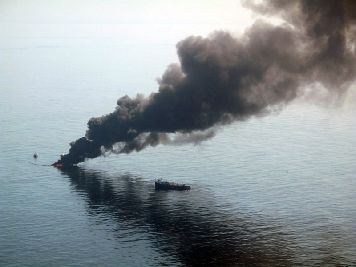In Situ Burn (ISB) Emissions Comparisons
The Newfoundland Offshore Burn Experiment (NOBE), so far the largest-scale experimental in situ burn, took place on August 12, 1993, offshore of Newfoundland, Canada, and was organized and coordinated by Environment Canada.
During each of two test burns, crude oil was poured into a U-shaped fire-proof boom and ignited. The first test burn lasted for an hour and a half and the second for about an hour, with an average burning rate of 200 barrels of oil per hour observed during both burns.
Table 1, below, compares the rate of emissions generated by the NOBE test burns to typical rates of emissions from slash burns of agricultural debris and other emission sources, such as woodstoves and power plants. Most of the information in this table was produced by Dr. Ron Ferek of the University of Washington in Seattle. Dr. Ferek assumed an oil burning rate during the NOBE burns of 200 barrels per hour.
In Table 1, the Average Emission Factor is the quantity in grams of a particular substance, such as CO2, emitted when 1 kilogram of oil was burned during NOBE. Emission Rate is the rate of emission of a particular substance measured during NOBE, in kilograms per hour. The Comparable Emissions column displays the magnitude or number of other emission sources that would produce about the same amount of a given substance as was generated by burning 200 barrels of oil during NOBE. For example, a 2-acre slash burn of agricultural debris would generate about as much CO2 as burning 200 barrels of oil.
| Substance | Average Emission Factor for NOBE (g/kg fuel burned) | Emission Rate (kg/hr) | Comparable Emissions from Other Known Sources |
|---|---|---|---|
| CO2 | 2,800 | 75,600 | approx. 2-acre slash burn |
| CO | 17.5 | 470 | approx. 0.1-acre slash burn or ~1,400 wood stoves |
| SO2 | ~15 | 405 | 7400 kg/hr. (avg. coal-fired power plant) |
| Total smoke particle | 150 | 4,050 | approx. 9-acre slash burn or 58,000 wood stoves |
| Sub-3.5-micrometer smoke particle | 113 | 3,050 | approx. 9-acre slash burn |
| Sub-3.5-micrometer soot | 55 | 1,480 | approx. 38-acre slash burn |
| PAHs | 0.04 | 1.1 | approx. 7-acre slash burn or ~1,800 wood stoves |
References
You can learn more about NOBE by reading the following reference:
Fingas, M.F., G. Halley, F. Ackerman, R. Nelson, M.C. Bissonnette, N. Laroche, Z. Wang, P. Lambert, K. Li, P. Jokuty, G. Sergy, W. Halley, J. Latour, R. Galarneau, B. Ryan, P.R. Campagna, R.D. Turpin, E.J. Tennyson, J. Mullin, L. Hannon, D. Aurand and R. Hiltabrand, "The Newfoundland Offshore Burn Experiment", in Proceedings of the 1995 International Oil Spill Conference, American Petroleum Institute, Washington, D.C., pp. 123-132, 1995.
You can learn more about Dr. Ferek's research from:
Ross, J. L., R. J. Ferek, and P. V. Hobbs. 1996. Particle and Gas Emission from an In Situ Burn of Crude Oil on the Ocean. Journal of the Air and Waste Management Association: 46 251-259.
Go back to the In Situ Burning page.
 An official website of the United States government.
An official website of the United States government. 
